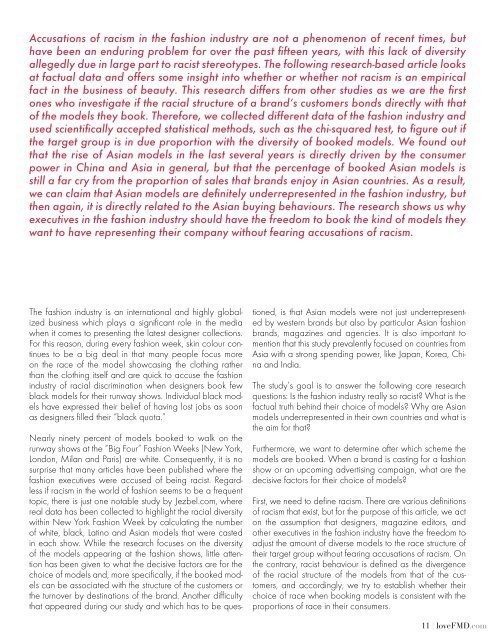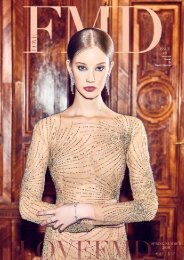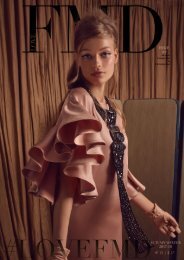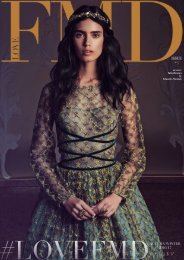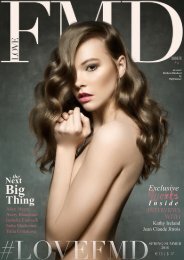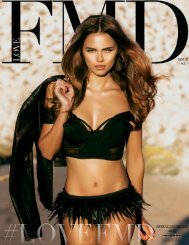#LOVEFMD
Our loveFMD Magazine aims at providing the full elegancy of the world of fashion in a new form and furthermore, we are reinventing the publishing of magazines with an innovative and unique marketing concept that unifies an interactive print and digital publication. Stay tuned and watch out for something new at your newspaper stand!
Our loveFMD Magazine aims at providing the full elegancy of the world of fashion in a new form and furthermore, we are reinventing the publishing of magazines with an innovative and unique marketing concept that unifies an interactive print and digital publication. Stay tuned and watch out for something new at your newspaper stand!
Create successful ePaper yourself
Turn your PDF publications into a flip-book with our unique Google optimized e-Paper software.
Accusations of racism in the fashion industry are not a phenomenon of recent times, but<br />
have been an enduring problem for over the past fifteen years, with this lack of diversity<br />
allegedly due in large part to racist stereotypes. The following research-based article looks<br />
at factual data and offers some insight into whether or whether not racism is an empirical<br />
fact in the business of beauty. This research differs from other studies as we are the first<br />
ones who investigate if the racial structure of a brand’s customers bonds directly with that<br />
of the models they book. Therefore, we collected different data of the fashion industry and<br />
used scientifically accepted statistical methods, such as the chi-squared test, to figure out if<br />
the target group is in due proportion with the diversity of booked models. We found out<br />
that the rise of Asian models in the last several years is directly driven by the consumer<br />
power in China and Asia in general, but that the percentage of booked Asian models is<br />
still a far cry from the proportion of sales that brands enjoy in Asian countries. As a result,<br />
we can claim that Asian models are definitely underrepresented in the fashion industry, but<br />
then again, it is directly related to the Asian buying behaviours. The research shows us why<br />
executives in the fashion industry should have the freedom to book the kind of models they<br />
want to have representing their company without fearing accusations of racism.<br />
The fashion industry is an international and highly globalized<br />
business which plays a significant role in the media<br />
when it comes to presenting the latest designer collections.<br />
For this reason, during every fashion week, skin colour continues<br />
to be a big deal in that many people focus more<br />
on the race of the model showcasing the clothing rather<br />
than the clothing itself and are quick to accuse the fashion<br />
industry of racial discrimination when designers book few<br />
black models for their runway shows. Individual black models<br />
have expressed their belief of having lost jobs as soon<br />
as designers filled their “black quota.”<br />
Nearly ninety percent of models booked to walk on the<br />
runway shows at the “Big Four” Fashion Weeks (New York,<br />
London, Milan and Paris) are white. Consequently, it is no<br />
surprise that many articles have been published where the<br />
fashion executives were accused of being racist. Regardless<br />
if racism in the world of fashion seems to be a frequent<br />
topic, there is just one notable study by Jezbel.com, where<br />
real data has been collected to highlight the racial diversity<br />
within New York Fashion Week by calculating the number<br />
of white, black, Latino and Asian models that were casted<br />
in each show. While the research focuses on the diversity<br />
of the models appearing at the fashion shows, little attention<br />
has been given to what the decisive factors are for the<br />
choice of models and, more specifically, if the booked models<br />
can be associated with the structure of the customers or<br />
the turnover by destinations of the brand. Another difficulty<br />
that appeared during our study and which has to be questioned,<br />
is that Asian models were not just underrepresented<br />
by western brands but also by particular Asian fashion<br />
brands, magazines and agencies. It is also important to<br />
mention that this study prevalently focused on countries from<br />
Asia with a strong spending power, like Japan, Korea, China<br />
and India.<br />
The study’s goal is to answer the following core research<br />
questions: Is the fashion industry really so racist? What is the<br />
factual truth behind their choice of models? Why are Asian<br />
models underrepresented in their own countries and what is<br />
the aim for that?<br />
Furthermore, we want to determine after which scheme the<br />
models are booked. When a brand is casting for a fashion<br />
show or an upcoming advertising campaign, what are the<br />
decisive factors for their choice of models?<br />
First, we need to define racism. There are various definitions<br />
of racism that exist, but for the purpose of this article, we act<br />
on the assumption that designers, magazine editors, and<br />
other executives in the fashion industry have the freedom to<br />
adjust the amount of diverse models to the race structure of<br />
their target group without fearing accusations of racism. On<br />
the contrary, racist behaviour is defined as the divergence<br />
of the racial structure of the models from that of the customers,<br />
and accordingly, we try to establish whether their<br />
choice of race when booking models is consistent with the<br />
proportions of race in their consumers.<br />
11 | loveFMD.com


